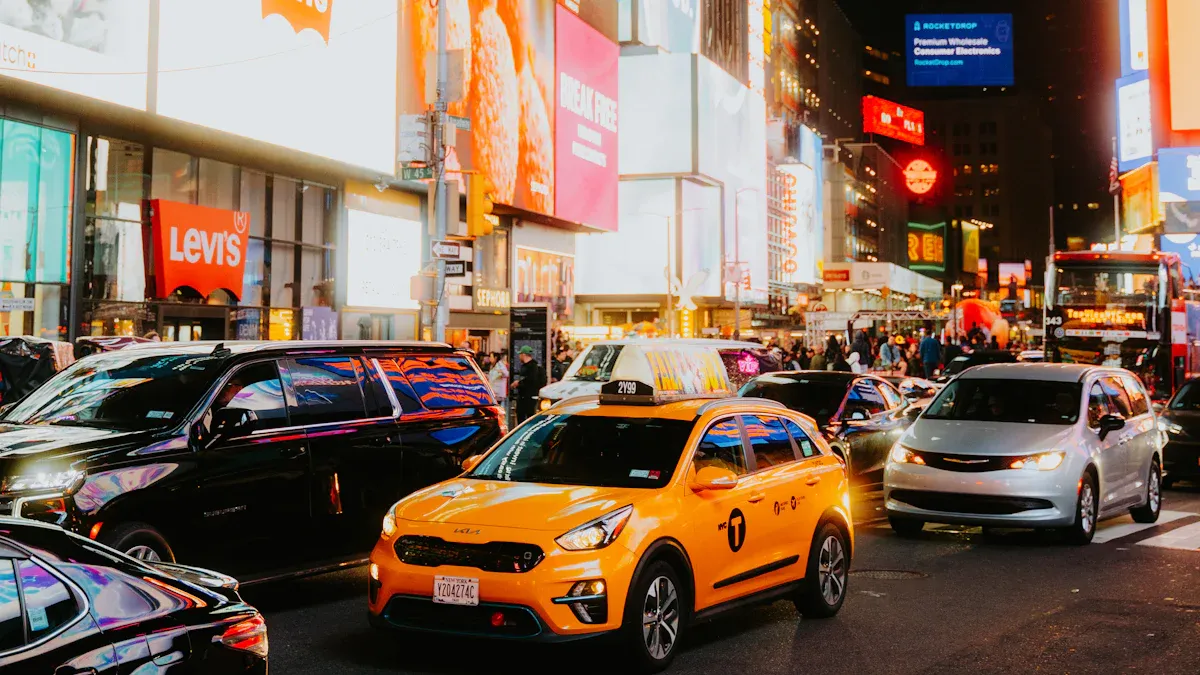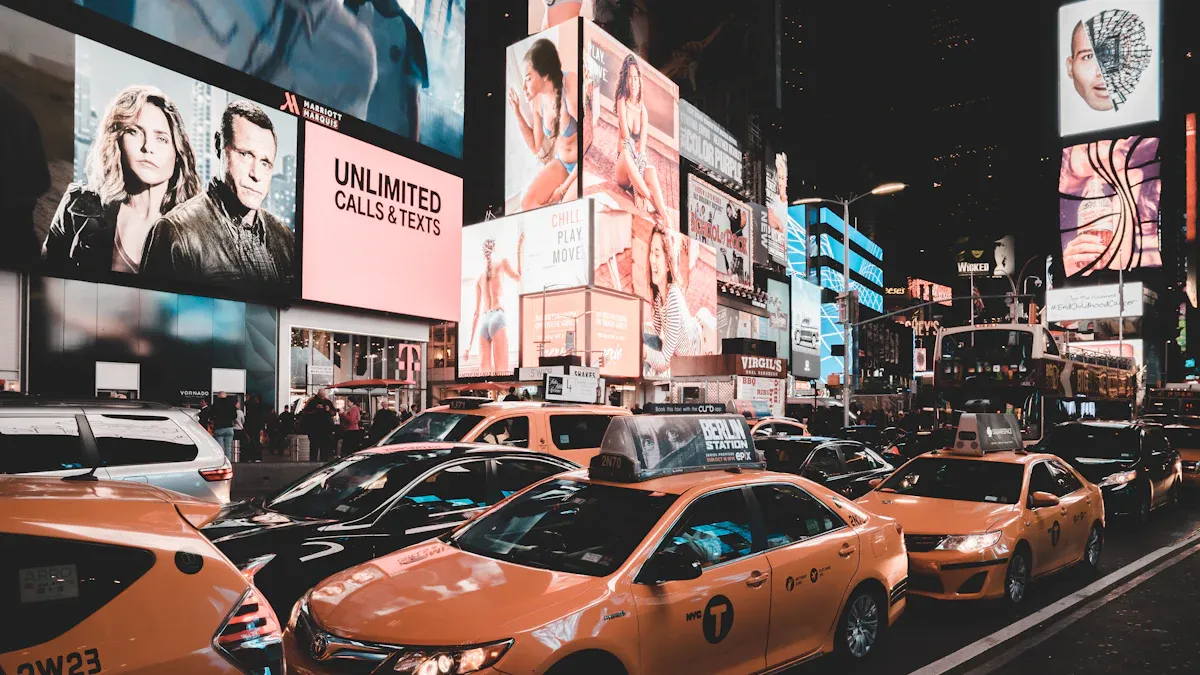
GPS-triggered taxi ads help brands talk to customers in new ways. These ads show messages at the right place and time. Businesses get more sales because ads pop up where people choose what to buy.
Brands can reach shoppers close to stores.
Ads change based on where the taxi is.
Companies can see results and make more money.
Smart advertisers use GPS-triggered taxi ads to make every ride a chance to sell more.
Key Takeaways
GPS-triggered taxi ads show messages at the best time and place. This helps brands reach people when they want to buy.
These ads use location data to target certain areas and groups. This makes ads more useful and better than normal billboards.
Taxi screens update ads in real time to keep them new and fun. This makes people want to act fast near stores or events.
Advertisers can see who looks at the ads and check results. This helps them make ads better and spend money wisely.
GPS-triggered taxi ads help businesses sell more, reach more people, and get more from their ad money.
GPS-triggered taxi ads: Targeted Reach

Location-Based Messaging
GPS-triggered taxi ads let brands talk to people based on where they are. Advertisers make geofences around places like malls, airports, or busy streets. When a taxi goes into these areas, the ad changes right away to fit the spot. For example, American Express used geotargeted ads in New York City taxis. They showed special deals as cabs drove by popular shopping spots. This real-time messaging gets people’s attention and makes them want to act while near stores or events.
Digital taxi top displays use GPS to update ads as taxis move. Brands can show local events, weather, or flash sales. This makes every message timely and important. This way, more people pay attention. Navori says there is a 40% jump in passenger engagement and a 25% rise in satisfaction compared to regular taxi ads. Passengers see ads that matter to them when they are ready to decide.
Brands using GPS-triggered taxi ads can turn each ride into a chance to reach customers at just the right time.
Audience Precision
Advertisers reach the right people with GPS-triggered taxi ads by using smart technology. GPS modules in taxi toppers work with cloud platforms to pick which ads play in each place. These systems can target neighborhoods, business areas, or even certain streets with very high accuracy. For example, a Brooklyn café used geofenced taxi ads during rush hour in cool neighborhoods and saw a 40% rise in people coming in.
Taxi ads move with crowds, reaching tourists, workers, and night visitors.
Advertisers can focus on busy places, like airports or downtown, for the most views.
Taxi ads cost less than regular billboards and are harder to ignore.
Advertisers use geotargeting to choose the best places for their ads. They send messages that fit the area, making ads work better and helping them earn more money.
Real-Time Engagement
Dynamic Ad Delivery
Digital screens in taxis use GPS to show ads that fit where you are and what time it is. Advertisers can pick when ads show up, like when a taxi goes by a busy store or a favorite restaurant. These screens play videos, pictures, and moving images that update right away with cloud systems. GPS lets brands make geofences, so ads change as taxis move into new places. For example, a restaurant chain used this to tell people about nearby spots. When taxis drove past, the screens showed special deals, and more people came in during busy times.
Taxi screens are bright and work in any weather. Brands choose what ads show and when by using smart tools. GPS also helps count how many people see each ad and how they react. This quick feedback helps advertisers change their ads for better results. Rideshare ads use GPS and what people do to show ads at the best times and places. This makes each ad matter more, so riders notice and might act.
When ads fit where riders are and what they need, every ride is a chance to connect and sell.
Immediate Action
Fast and useful ads make people act quickly. GPS-triggered taxi ads reach riders when they are near stores or events, so it is easy for them to visit or buy right away. Studies show that ads with words like “taxi service near me” or “airport taxi now” get more bookings because they show up when people need them most. Real-time signals and local ads help brands reach people when they want something. Audience groups let advertisers show different ads to business travelers or regular riders, which helps more people book rides.
Changing keywords and special pages help more people finish bookings.
Platforms use real-time data to show better ads.
Campaigns that focus on quick reach and local ads see better sales.
Research shows people like ads that match their place and culture. When ads feel local and timely, riders are more likely to use the app and buy something. GPS-triggered taxi ads use this idea to make campaigns that really work.
Data & ROI

Campaign Tracking
Advertisers want to see if their ads work well. GPS-triggered taxi ads make this simple. GPS data shows where taxis go and who might see the ads. Marketers use special tools to match taxi spots with phones nearby. This helps them know which people saw the ad and how close they were. Geo-fencing counts real views, not just guesses. Marketers can even check if people visit stores after seeing an ad. This gives a clear picture of how the campaign is doing.
GPS data matches taxi trips with phones to find real viewers.
Geo-fencing finds people most likely to see the ad.
Marketers get reports on who saw the ad and what they did next.
Online retargeting shows ads again to people on their phones.
Store visits from these phones show if ads make people act.
Marketers use dashboards and tools to see results fast. They can test different ads, get feedback, and change plans quickly. This helps them spend money on ads that work best.
Good tracking means advertisers know how many people see their ads and what happens next.
Revenue Insights
Data helps advertisers make more money. When marketers see which ads get the most attention, they can focus on what works. GPS-triggered taxi ads let them reach people who are ready to buy. Studies show people who see these ads are 2.7 times more likely to click banners and 2.5 times more likely to visit stores. This leads to more sales and better results.
Transit ads, like taxis, make up 31% of out-of-home ad spending.
Digital out-of-home ad spending grows every year.
Location-based ads bring in more money as more people use mobile devices.
Taxi ads can target tourists, locals, and people near stores for more sales.
In-car ads reach people while they travel, opening new ways to earn.
Advertisers set clear goals and track numbers like views and store visits. They use GPS and mobile data to see which ads work best. This helps them change campaigns and get the most return on investment.
Aspect | Privacy Considerations | Regulatory Considerations |
|---|---|---|
Employee Tracking | Companies can track taxis, sometimes without drivers knowing. This can cause privacy worries. | Laws control how long companies keep data and how they use it. New rules may limit how companies use GPS data. |
Data Retention & Use | People worry about how long companies keep location data and why. | Agencies check if companies follow the rules. Companies must have clear data policies. |
Application to Taxi Advertising | These privacy issues matter for GPS-triggered taxi ads because they use location data for ads. | Taxi ads must follow the same privacy and data rules as other GPS uses. |
Marketers who use data the right way can boost sales, reach more people, and stay ahead of others.
Advertisers get real results by using targeted reach, real-time engagement, and data-driven ROI. The table below explains how each benefit helps sales:
Benefit | Description | Sales Outcomes |
|---|---|---|
Targeted Reach | Focuses on certain places to find the right customers | More people pay attention and buy more |
Real-Time Engagement | Shows ads when people enter important spots | More people visit and act right away |
Data-Driven ROI | Uses data to check and improve ads | Better sales and smarter spending |
Experts suggest these steps for success:
Show ads that change with location, time, or events.
Buy the best display screens for taxis.
Use smart data to target the right people.
Work with big ad networks for more reach.
Check results and make ads better with data.
New tech and good partners help get better results.
North America is leading with new ideas and use.
Companies that start now can get ahead and make more money with this strong ad plan.
FAQ
How do GPS-triggered taxi ads increase sales?
GPS-triggered taxi ads show messages to people near stores or events. These ads reach buyers at the right time. Brands see more visits and purchases because the ads match what people need right now.
Are GPS-triggered taxi ads expensive?
These ads cost less than many billboards. Brands pay only for ads shown in key areas. This smart spending helps companies get more value and higher returns.
Can advertisers track results from taxi ads?
Yes. Advertisers use GPS data to see where ads play and who sees them. They check store visits and online actions. This tracking helps brands improve campaigns and boost sales.
Do riders like seeing these ads?
Many riders enjoy ads that match their location or needs. Relevant ads feel helpful, not annoying. Brands that use local offers often see better feedback and more happy customers.
What types of businesses benefit most from GPS-triggered taxi ads?
Retail stores, restaurants, and event venues gain the most. These businesses reach people ready to buy or visit. GPS-triggered ads help them stand out and drive quick action.
